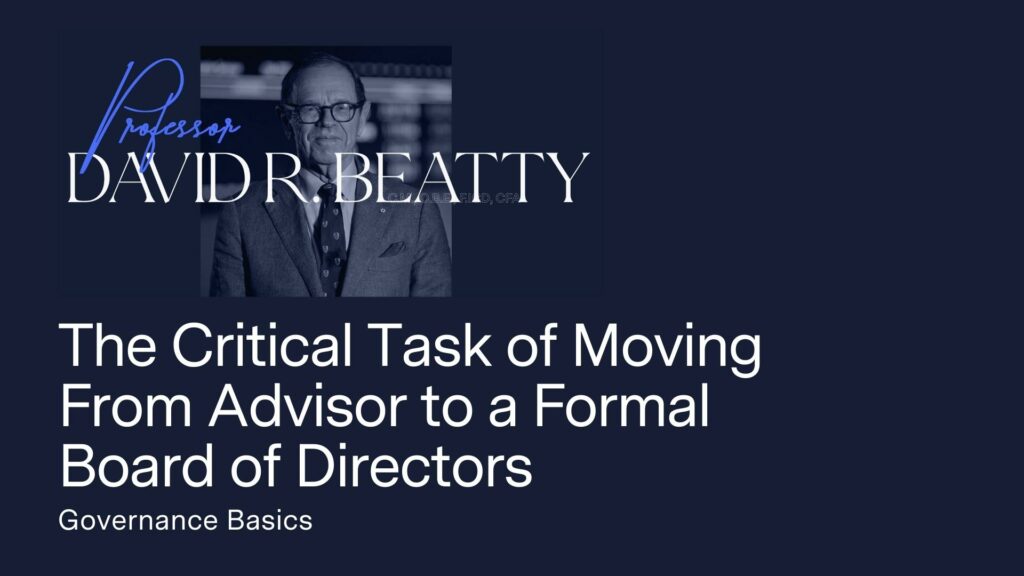If you’ve got your advisory board, you can migrate it into a more fiduciary board or another kind of structure on your own. Or, if you’re getting more funding from outside, you may be forced into different structures. For example, if you’re in a private funding equity arena, your new investors might insist they get maybe one or two board seats. And by the time you get through four fund raising rounds, you might well have a board of directors that has three asset managers on it. And typically, at that time, they may decide they need a new CEO, new entrepreneur, new leader.
My advice: if you are building with external capital and you need that capital to keep growing, then make very sure you do some due diligence on your new partners.
You can’t just accept the money. If you have any options at all, you’ve got to take a look at prospective partners; ask others who they worked with, ask what they’re like on a board. Because investors can typically be thinking really short term, with a kind of a slash and burn approach. Those characteristics vary dramatically from directors that are reasonably benign and will let you run your company and grow your business.
Most investors are very congenial; they all look very good, and they might write you that cheque. But if you’re building your business using external funding from various PE and VC players — and you still have an option — make sure you check them out as directors and as co-owners of your business. You’ll be very sorry if you don’t, and the statistics clearly show that above four financing rounds, you may well be out of a job and out of the company, forced out.
On the other hand, if your trajectory is that you’re self-funding and you’re thinking about growing your board into more of a fiduciary board, where the directors have a responsibility called a fiduciary responsibility to the company, then you’re moving into a much more formal kind of a structure. And it might be a good first step towards understanding what it would be like to be running a public company with a fiduciary board in that domain. At least in this case, there’s only you to report to, or only the other owners. When you go public, you’re going to be reporting to your public owners as well. And that’s a significantly more difficult business.
You’ve got to be thinking about getting a return on your investment from that board investing 15-20% of your time to the governance structure. And this is a really important word choice. Never again ask “How did we spend our time as a board?” The better question is, “How do we invest our time as a board?” Because an expense is gone, but an investment decision implies a return.
I always try to discipline myself to think about an agenda for a Board of Directors meeting as being an investment decision — and a huge one. For a couple of weeks before a board meeting, you’re going to take 20% of your management time getting ready. Then you’re going to have the board meeting itself, when you’re bringing in the external people, as well as your own management team. It’s a huge time investment decision. So regard it that way. Think about the ROI. And that will mean you’ll be continually worrying about whether you as the CEO, founder, entrepreneur are getting value out of the board.
I spoke with somebody from a startup who was beginning to migrate to a board structure. He spoke to me in March and said, “David, I want to have a fully functioning board by the end of June.” I told them there was no way. That was just a few months —
March, April, May, June. They might have added one new director to their board by the end of June. You need to give yourself a lot of space; it can take a year or two to build your board, brick by brick.
Reid Hoffman, the founder of LinkedIn and a widely respected Silicon Valley entrepreneur has written:
“I believe the wrong board member can break your company faster than the right board member can build it. So, when building a Board choose wisely.”
Every single addition to your board is really vital. And unless you have that careful craftsmanship, you’ll be building something that’s going to suck a lot of your time away, without any return for your investment. So, migrating from an advisory structure, either into a venture capital structure or into a fiduciary structure is a really important transition that you want to give a lot of thought to.
David Beatty is an adjunct professor and Conway chair of the Clarkson Centre for Business Ethics and Board Effectiveness at the Rotman School of Management. Over his career, he has served on more than 39 boards of directors and been chair of nine publicly traded companies. He was the founding managing director of the Canadian Coalition for Good Governance (2003 to 2008). A version of this article will also appear in the Winter 2017 edition of Rotman Management, published by the University of Toronto’s Rotman School of Management.
